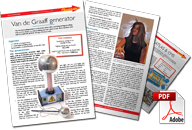Electrical resistance
Electrical resistance can be considered rather dryly as the R in V = IR. However, we can show its effects more spectacularly as a shower of sparks when wire wool is placed over the terminals of a battery.
Apparatus
5 × battery
some wire wool
1 × heatproof mat
Safety
Safety specs should be worn for this demo because it creates very hot sparks. It is largely smokeless, but do be aware of any smoke alarms, heat detectors etc.
The demonstration
- Pick up a clump of wire wool with a pair of tweezers and place it across the terminals of a suitable battery.
- Small, bright sparks will start crawling along the length of some of the wires. When this starts happening, take the wire wool away from the battery and wave it through the air to fan the flames. If you just leave it on the battery, the results may be unspectacular!
- Take care that the sparks don’t land on anything which may catch fire or melt, including flooring—use of a heatproof mat is advised.
Vital statistics
melting point of iron:
1535°C
current carried in LHC magnets:
11,850 A
How it works
This demonstration shows the effect of electrical resistance. When an electric current flows through an ordinary conductor, the electrons don’t flow smoothly like water through a pipe. They bump into the material they’re flowing through, which means that they lose energy to the material, which therefore heats up. This phenomenon is observed in a rather more controlled fashion in electric kettles, hobs and heaters, when resistive heating warms your water, your dinner or the air in a room.
This poses a fundamental limit on how much electric current can be passed through a conventional conductor before it heats up to a dangerous degree and melts or catches fire. This effect is used in fuses to cut off the flow of electricity if a certain threshold current is exceeded. However, when designing a high-field electromagnet for a particle accelerator, this is a design limitation, and motivates the use of superconducting magnets.
There are two ways to work out just how hot this wire wool gets. The colour a hot material glows can often give a clue as to its temperature. Objects start giving off a significant amount of visible light when they exceed 500°C, becoming red hot. The wire wool glows white in this experiment, indicating temperatures in excess of 1500°C, further confirmed by the fact that the metal will sometimes melt, cooling to form small globules. Iron melts at 1535°C, so this stuff really is very hot!



